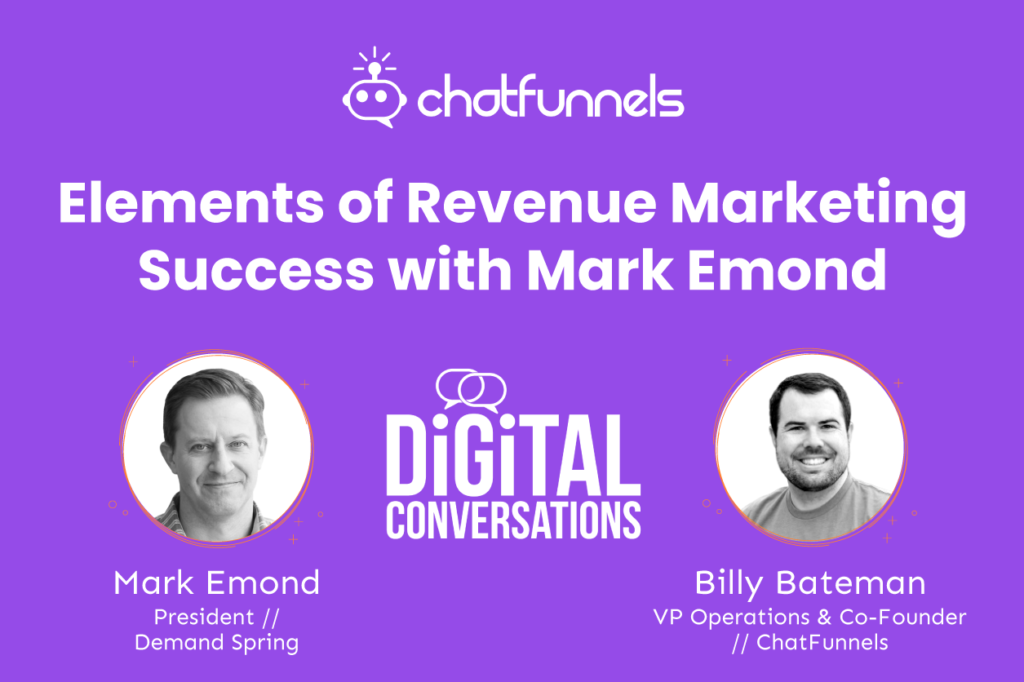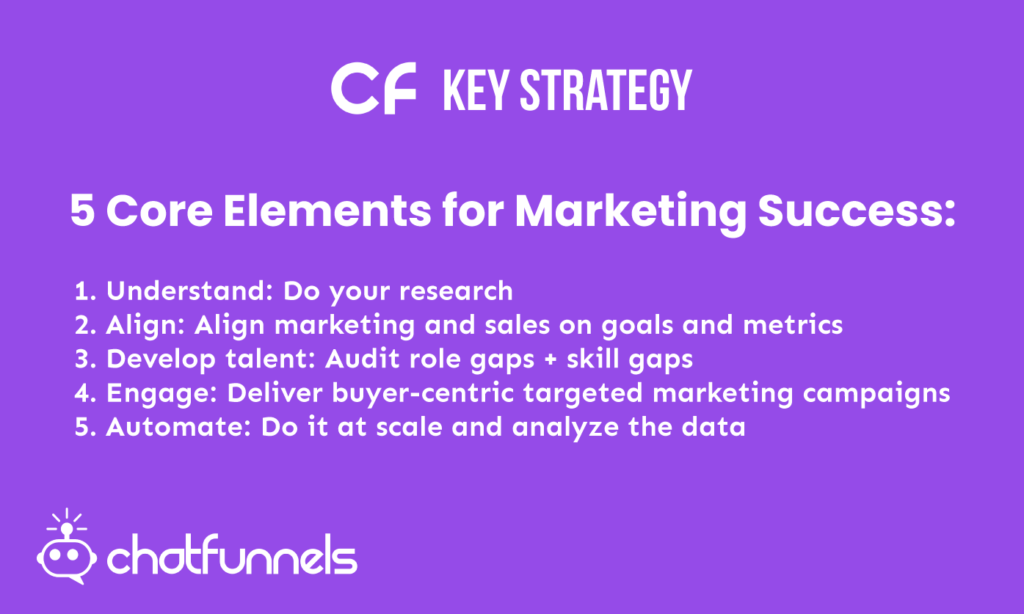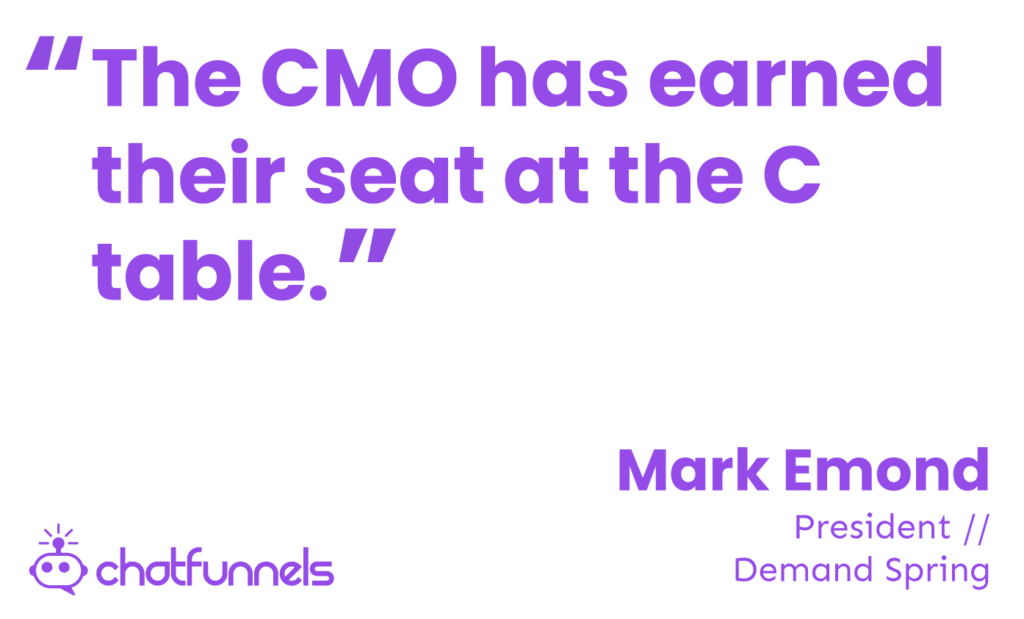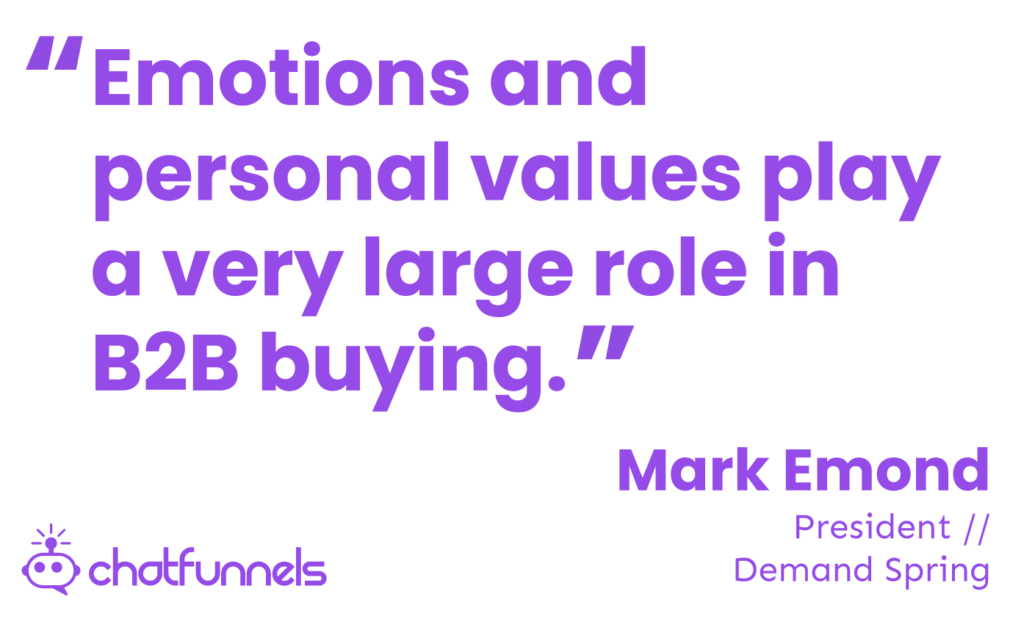Elements of Revenue Marketing Success with Mark Emond

Overview
Mark explains 5 essential aspects of revenue marketing success, including research, alignment, development, engagement, and automation. Note: this episode was taken from a recent presentation at the Demand Gen Summit 2021.
Guest
Mark founded and leads Demand Spring, an organization of dynamic, experienced individuals with a passion for working with B2B Marketers in building the marketing strategies, content, and technology stacks that drive transformation and top-line results. We work with organizations ranging from early-stage to many Fortune 500 organizations.
Reference
<iframe height="200px" width="100%" frameborder="no" scrolling="no" seamless src="https://player.simplecast.com/eb4e57b4-1490-45a9-8fab-0354490ac5ff?dark=false"></iframe>0:01
Intro to Marketing Success
Everyone, Mark Emond here with Demand Spring, delighted to be with you today. I am going to give you a year. And I want you to think about it for a moment. I’m going to give you a few moments. I will pause and I want you to think about what that moment means to you. The year was 1996.
0:21
All right, have you connected that to what that means to you? For some of you, maybe that was the year that you were born, for others, maybe you weren’t even born, then maybe your parents got married that year, or maybe you got married that year. Maybe you graduated from college that year.
0:36
For me. 1996 was the year that I started my b2b marketing career. I had graduated from university a couple of years previous to that. I backpacked through Europe with my girlfriend at the time, now my wife, Sue. We had a great time traipsing through Europe eating baguettes and Gouda cheese, and crepes. I had gotten back and decided Now is the time to start my career. And I thought it was going to change the world as a b2b marketer.

Going back to 1996
1:04
Well, little did I know that in 1996, my job as a b2b marketer was essentially to keep the food warm, and the beer cold. Now, I’m being a little facetious, but just a little as it turns out, see, back in 1996, the internet had just been commercialized the year Previous to that Google was just a tiny company back then there was no Amazon, there was no Netflix.
1:30
Microsoft was rolling the world with Microsoft Office and Windows 95. And marketers’ jobs back then were really subservient to sales. b2b sales definitely ruled the role to go to market roost in organizations. And our job was to really support b2b sales.
1:51
There was no digital marketing, there was no content marketing, martech was not a thing. Social media was not a thing back then. So that was, that was my job. That was my life back then it was really supporting sales. Now, let’s fast forward to today. And I want you to think about your role as a marketer today. How important are you to your organization?
2:18
How Important is Marketing to the Strategy of your Organization?
Take a moment to just think about that, how meaningful are you to the overall results, and performance and the strategic nature of your organization. So, I would hypothesize that most of you are probably pretty important to your organization, that today, the b2b buyer, as we know, engages with marketing channels. marketing content through much of their buyer journey, in a nonlinear manner.
2:50
they’re going back and forth between sales and marketing, for education, for inspiration, for connection with your brand, to build trust, to build an understanding of your brand, your products, your services. And ultimately, you’re a big part of conversion. There’s been a lot of changes in the b2b buying process.
3:12
Metric Marketers are Measured on
We know that today, based on research that demand spring has done, that revenue is the number one metric that b2b marketers are measured on over 53% of b2b marketers have that as their primary metric revenue as the primary metric that they are measured on. And we know that 55% of b2b marketers are expected to initiate more than 30% of new pipeline, and 31% are expected to initiate more than 40% of pipeline.
3:41
So today, I think it is very fair to say that the CMO has earned their seat at the C suite table. or they’re expected to have a seat at the C suite table, they’re being held accountable for the metrics that matter to the C suite. pipeline, revenue, earnings valuation, we are more impactful to the top line of the organization than we’ve ever been.
4:09
How can you Drive Revenue from Marketing?
Now, I want you to think about what systems you have in place to actually drive revenue from within marketing. And I’m not just talking about technology systems I’m talking about, do you have a codified system in place to think about, plan, execute, measure and analyze your revenue marketing results?
4:32
You know, if we think about systems in our lives, and I want to take us back to you know, even the most basic of systems that we as humans use tying our shoes. So, Hands up, if you are a parent, I’m a parent. If you’ve taught your child how to tie their shoes, I’ve been part of that. Or maybe you’re not a parent, but you remember when your parents taught you how to tie your shoes. That was a system, and it was a system stuff that was needed,
5:00
Systems for Marketing Results
right, you are probably your system probably looked like, you kind of pull on your laces and then you cross them over, maybe you’d make those bunny years. And then you cross the bunny ears over and bring them through, right. And that’s how you learn to tie your shoes. That was a system, a very basic system, but an essential one, for walking outside.

5:24
Now, there are all kinds of systems in life sales and b2b organizations, they have systems usually they have a selling system or a sales methodology different. There are different types of sales methodologies, sales systems that are out there.
5:39
I want you to go back and ask yourself, do you have a revenue marketing system in place? Have you codified a replicable process for driving the top line? Most organizations have in our experience, we are a revenue marketing agency that works or consultancy that works with organizations of all sizes from high, high growth, early-stage technology companies to fortune 1000 organizations.
6:03
The Revenue Marketing System
And when we go in, and we talk to them about revenue marketing, and we ask them the system they have in place for driving it, most of them aren’t able to identify a set of codified practices. So, we have created one called the revenue marketing system, that at its heart has five core elements to it. And we believe these elements are essential elements in really optimizing your ability as a marketer to drive the top line of the organization. we’ve, we’ve observed this, through our work over I’ve been working out for over 25 years, exclusively in revenue marketing, or demand generation as it was years ago.
6:50
And really looking at and observing. And then our work at demand spring over the past 10 years working with so many clients that we’ve worked with, we’ve observed that revenue Marketing Leaders do these five things exceptionally well. So, I want you to take out a pen or type these five words, and I’m going to spend the rest of my presentation going through these five and really give your insight into the types of things that you can be putting in place to drive a repeatable, scalable process for contributing to the top line of the organization.
7:25
Understand, Align, Develop, Engage, Automate
The five words are understood, align, develop, engage, and automate. I’m going to take you into each of those five. And I’m going to describe more about the key things that you should be considering each of those five.
7:44
Step 1: Understand
So, let’s start with understanding, you know, in my experience, and, and I am as guilty of this as anyone else. When I was on the client side, many b2b marketers today have an understanding of their buyer based on anecdotes based on feedback based on assumptions. Maybe it’s based on some data as well, that’s great.
8:10
But what they haven’t necessarily done is deep primary research, a combination of qualitative and quantitative research, to really uncover what their buyers are thinking, feeling and doing in each stage of the buyer journey.
Understand your Personas
8:28
And that’s what an understanding element of the revenue marketing system is about really understanding each of your buyer personas, or your customer personas throughout the client lifecycle, and the buyer journey, and customer journey that they’re on. And it’s not just about demographics, and firmagraphics, that they’re, you know, X percent male, and they, you know, typically are within this age range.
8:55
They have this educational background, they work in organizations of this size, what we really want to uncover when we do buyer journey analysis is what buyers are thinking, feeling and doing in each stage of the buyer journey. And that comes from doing primary research in the form of qualitative interviews, interviews with prospects who didn’t convert, and customers who did convert. You want to ask them a bit about their buying process in each stage of the buyer journey, and the awareness, consideration and decision phases, the buyer journey.
Customer Journey
9:30
And then if we move on to the customer journey and the onboarding phases, in the up and running and performing over to being an advocate, and then buying more cross selling and upselling what were they thinking feeling and doing each of those stages. So, what were their triggers to move from stage to stage that can really inform your messaging.
Emotional Aspect
9:51
What were they feeling in each stage emotionally? We know the role of emotions and personal values plays a very large impact on b2b buying. Spend a lot of stuff that validates those personal values and emotion play a larger role than professional values and rational capabilities and features when it comes to b2b buying.
10:10
So, we really need to uncover in that process, what your buyers are thinking and feeling and each stage of the buyer journey so that you can tap into those feelings in each stage of the buyer journey in your messaging, and then your calls to actions. And then in terms of doing we really need to uncover,
10:28
Where are they going? What content are they engaging with? Which watering holes are they living in? What digital channels and physical channels are they engaging with? Right?
10:38
When you have that kind of information, then you can create a marketing plan that is based on reality and not assumption, you create a blueprint for engagement. But it’s not enough in the understanding stage, just to understand, you’ve got to operationalize that understanding as well.

10:56
And frankly, we see many organizations today who’ve done a pretty good job of creating buyer journey insights through primary research through analytics, diving into your data as well using your data scientists and your business intelligence or analytics tools to uncover buying patterns, maybe interviewing sales as well as one element. But what they haven’t typically done is they haven’t figured out how to operationalize their buyer journey understanding.
11:24
Information in Silos
They haven’t organized their campaigns or agile sprints around their buyer personas, or their target segments infused with all of the thinking, feeling and doing elements in each stage of the buyer journey. Right or maybe a group has, but it hasn’t become institutionalized across marketing, right? The information lives in silos and isn’t really an organizing principle for all of the various disciplines in marketing to organize and execute around.
11:54
So, understanding, it’s critical to have two things go right in that stage. One is doing the research to uncover the insights. And two is figuring out how you’re going to operationalize it across your marketing team and across to your sales organization.
Step 2: Align
And that leads us to our second core element of the revenue marketing system. I’m going to talk about aligning both sales and marketing, and also aligning marketing. So
12:20
Hands up, if you feel like you have done a really good job within your organization of aligning sales and marketing, that sales and marketing have a one mindset philosophy, there’s no finger pointing that you feel like you are going to market as one unified go to market function versus two separate departments or organizations. And that you’ve aligned on core elements like lead taxonomy, lead management processes, you’ve got planning and communication processes and practices that are well aligned, you measure pipeline together on an ongoing basis.
Customer is in Control of the Buyer Journey
12:59
We see a lot of organizations still struggling in this regard. I think organizations have come a long way in realizing that they need to get together in a more structured way, that the buyer is in control, that sales is not the channel today in b2b for selling a channel, just as marketing is but neither is in control. The customer is in control of the buyer journey. And they are choosing to interact with both marketing and sales. When they choose through the channels that they choose to, to interact with and engage with them, and with the type of content that they prefer, as well.
13:38
So, marketing and sales has to work together in a unified manner, to really serve the buyer and be buyer centric today. They cannot operate in silos. So, what that takes, first of all, is the spirit of working together, there’s got to be one mindset, one philosophy that we have to go to market together. You have to align on your lead taxonomy. What’s a marketing qualified lead? What’s a sales qualified lead, what’s a sale accepted lead, you’ve got to optimize your lead management processes, we see a lot of leaky pipes.
Work together
14:09
Today still in organizations that need to be optimized. You’ve got to work together on your planning and communication processes, right? It’s not enough for marketing to plan their marketing campaign sales to plan their sales plays, and the two don’t meet, right or maybe you plan them independently, and then you communicate what they are, but they still don’t meet. Right, you’ve got to plan them together.
14:31
Think of it from a customer perspective, the customer is interacting with you in a nonlinear manner. So, you’ve got to react in a unified manner, not a siloed manner. You’ve got to plan and communicate. You also need to ensure that you’re measuring the pipeline together.
Meeting together
14:47
We see the best companies have marketing and sales at the table every week, reviewing pipeline down to the regional field level, the regional marketing manager, the regional sales leader in each region through the world is reviewing if they’re on target or off target for this month, next month, two months, three months, likewise quarters, pipeline contribution and pipeline attainment.
15:12
And if they’re off target, they come to the table together to identify those gaps and they plan for it. So, sales and marketing alignment, super critical. Marketing alignment, also really critical. We see a lot of silos existing today within marketing. Think about an audit, if you’ve got marketing silos that exist today, how do you break those down? So, we’ve talked about understanding, we’ve talked about alignment, let’s talk about engagement, let’s talk about development.
15:39
Step 3: Developing Talent
Now, when I talk about development, I’m talking about developing talent, it’s often the Forgotten thing. We’ve spent a lot of time as marketers over the past few years, optimizing our practices, our processes, implementing lots of technology, what we haven’t necessarily done is really built a fundamental talent plan within marketing, auditing our role gaps, auditing our skills, gaps, developing talent plans, and driving talent execution, optimization.
16:06
Those are things that, you know, we feel fundamentally are critical to scaling and driving marketing as a real strategic function within the organization, you’ve got to optimize your talent, there needs to be more coaching and teaching. We do a lot of delegating. Typically, as marketing leaders, we don’t do enough coaching and teaching. So, developing talent is the third foundation of the revenue marketing system. The fourth is engaging.
16:33
Step 4: Engage
And when I talk about engage, I’m talking about delivering into the market buyer centric multi-channel engagement campaigns. Right. So, I want to break that down. buyer centric means you’re taking the insights from your understanding element of the revenue marketing system, they are understanding what buyers are thinking, feeling and doing and you’re creating marketing campaigns, or agile sprints based on those insights.
16:59
They’re multi-channels in nature, you are existing with your marketing and all of the channels and the watering holes that your buyers go to. That’s on your website that’s in their inbox that’s in their social channels, through display ads, that’s through web personalization. That’s through chat, right.
17:18
And it’s not siloed messaging. It is contextual, relevant messaging, across channels using the data that sits in core systems like your marketing automation platform, and your CRM platform. And they’re all tuned to the stage that each individual is in their buyer journey. So, you’re doing very targeted, maybe account centric, or persona centric campaigns across multiple channels, delivering those with great content that engages, that educates, that inspires, that’s evocative, and ultimately, that converts. The last thing I want to touch on is technology.
17:54
Step 5: Automate
And that is the pillar in our fifth element of the revenue marketing system, which is automation. So, an automate, it’s taking everything that I’ve talked about and doing it at scale, it’s driving those multi-channel engagement strategies in a one-to-one manner, but at scale. And that’s where your Mar tech stack comes into play.
18:11
Do you have the right technology in place to be able to drive multi-channel engagement at scale, and not only drive it but also analyze it? And that’s still a big gap for most marketers today is the analysis. It’s having that insight from the data in a manner that is easy to get at to understand, to interpret, and to drive.
18:34
And that’s where I’m a big believer that not only analytics, but data scientists, who can really deliver those insights to marketers who are so busy executing are really critical. So those are the five elements of the revenue marketing system, understand, align, develop, engage, and automate. Where do you start is the question, what I recommend is audit where you’re weak, assess, and optimize those areas doesn’t have to be linear, you can start anywhere in those five,
19:05
Maybe you have a good understanding of your buyer personas, but you have poor alignment, or you don’t have the right technology, but a lot of technology, but you haven’t bought the right technology. So, you really need to audit and assess your use of your Mar tech stack. Right? Or maybe you’ve got some talent gaps that you need to address before you’re really going to start to outperform. The one area that I do think is foundational to the others is understanding.
Outro
19:30
I think if you don’t have that fundamental understanding, if you’re guessing, if you’re assuming which channels, which messages, which, you know, buyers that are part of the buying team in a complex b2b buying process are part of your buyer journey. Then you’re going to spend a lot of money on execution, on alignment, on engagement on technology, and there’s a lot of potential to waste it.
19:57
So, the revenue marketing system Something that again, we see used by organizations that are really advancing marketing’s ability to contribute to the top line. Like with anything from tying your shoes to b2b selling, consider if you have a revenue marketing system in place, and if not, we recommend really looking at optimizing and making progress in the five areas that I described today. Thanks, everyone. Enjoy the rest of the conference.
